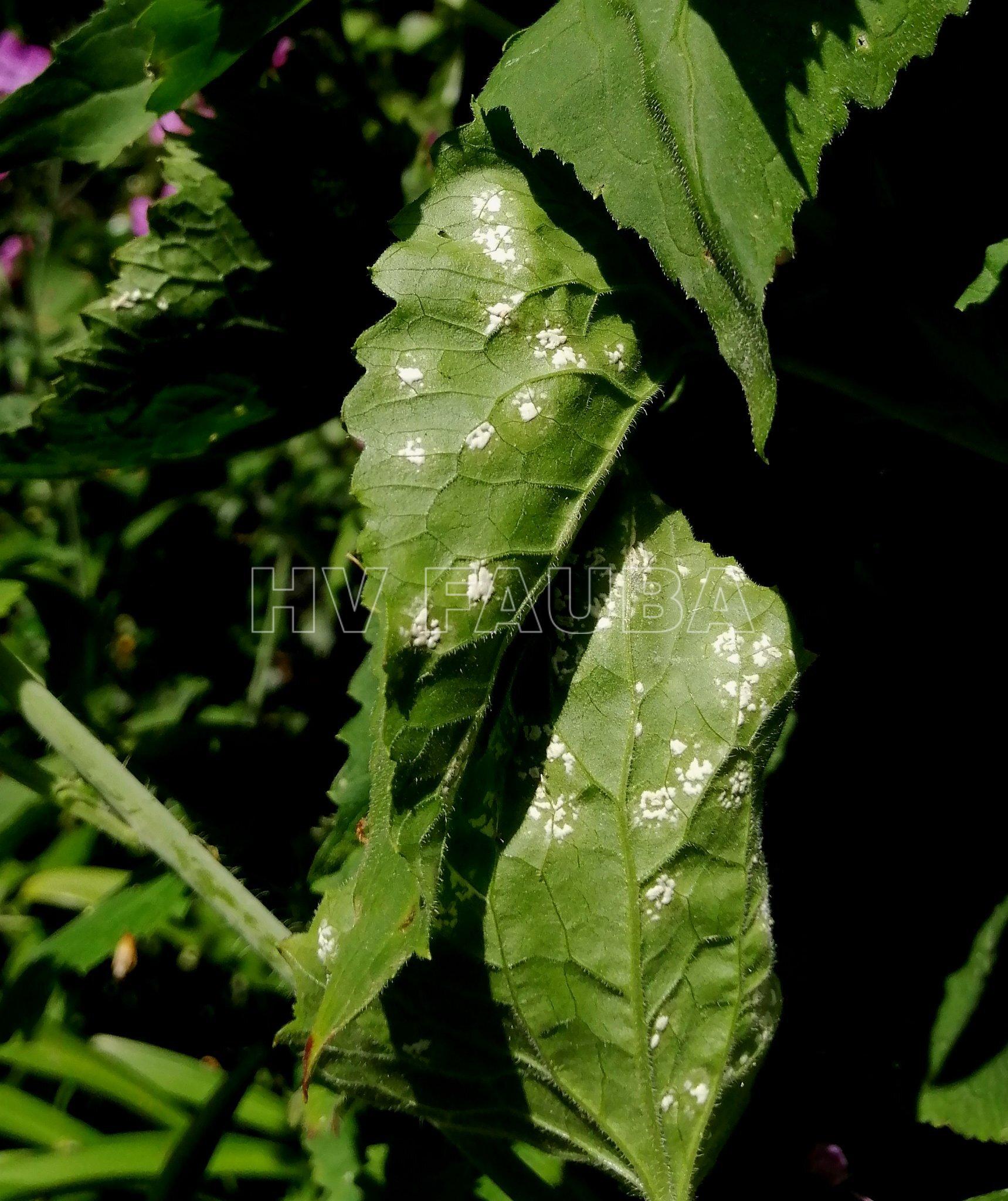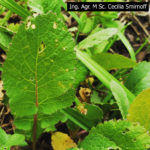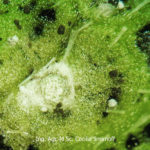.
Condición fitosanitaria: Presente
Grupo de cultivos: Hortícola, brasicáceas (Brassicaceae) o crucíferas (Cruciferae)
Especie hospedante: Rabanito (Raphanus raphanistrum subsp. sativus)
Rango de hospedantes: Cruciferas, principalmente de los géneros Brassica y Raphanus.
Etiología: Pseudohongo (Oomycete). Biótrofo
Agente causal: Albugo candida
Taxonomía: Stramenopiles > Oomycetes > Albuginales > Albuginaceae > Albugo
.
.
.
Síntomas y signos
Se observan pústulas zoosporangiales en el envés de las hojas, agallas del tallo en forma de huso, hipertrofias florales, hipertrofia de inflorescencias enteras o partes terminales de inflorescencias e infecciones de vainas. Las pústulas zoosporangiales pueden cubrir los órganos florales hipertrofiados.
El pseudohongo crece con micelio intercelular hialino, formando haustorios globosos. Los zoosporangios se disponen en cadenas, son globosos a ovales, hialinos. Las oosporas pueden permanecer infestando en semilla y suelo.
En general los daños y pérdidas económicas no son graves, pero dependerá del nivel de inóculo inicial y las condiciones ambientales durante el crecimiento del cultivo.
.
- Autor: John Mansfield
.
Los síntomas pueden incluir agallas del tallo en forma de huso, hipertrofias florales, hipertrofia de inflorescencias enteras o partes terminales de inflorescencias e infecciones de vainas. Las pústulas zoosporangiales pueden cubrir los órganos florales hipertrofiados.
El hongo crece con micelio intercelular hialino, con haustorios globosos. Los Zoosporangios se disponen en cadenas, son globosos a ovales, hialinos. Las oosporas pueden permanecer infestando en semilla y suelo.
En general los daños y perdidas económicos no son graves.
.
- 01 Roya blanca del rabanito, causada por el pseudohongo Albugo candida
- 02 Roya blanca del rabanito, causada por el pseudohongo Albugo candida
.
.
Bibliografía
Castel B, Fairhead S, Furzer OJ, et al. (2021) Evolutionary trade-offs at the Arabidopsis WRR4A resistance locus underpin alternate Albugo candida race recognition specificities. Plant J. doi: 10.1111/tpj.15396
Cooper AJ, Latunde-Dada AO, Woods-Tör A, et al. (2008) Basic compatibility of Albugo candida in Arabidopsis thaliana and Brassica juncea causes broad-spectrum suppression of innate immunity. Mol Plant Microbe Interact. 21(6): 745-56. doi: 10.1094/MPMI-21-6-0745
Eitzen K, Sengupta P, Kroll S, Kemen E, Doehlemann G (2021) A fungal member of the Arabidopsis thaliana phyllosphere antagonizes Albugo laibachii via a GH25 lysozyme. eLife 2021;10:e65306. doi: 10.7554/eLife.65306
Furzer OJ, Cevik V, Fairhead S, et al. (2021) An improved assembly of the Albugo candida Ac2V genome reveals the expansion of the “CCG” class of effectors. bioRxiv preprint Mar 29, 2021 doi: doi: 10.1101/2021.03.29.437041
Gómez-Pérez D, Schmid M, Chaudhry V, et al. (2022) Proteins released into the plant apoplast by the obligate parasitic protist Albugo selectively repress phyllosphere-associated bacteria. bioRxiv 2022.05.16.492175; doi: 10.1101/2022.05.16.492175
Jouet A, Saunders DGO, McMullan M, et al. (2019) Albugo candida race diversity, ploidy and host-associated microbes revealed using DNA sequence capture on diseased plants in the field. New Phytol 221: 1529-1543. doi: 10.1111/nph.15417
Kaur P, Jost R, Sivasithamparam K, Barbetti MJ (2011) Proteome analysis of the Albugo candida–Brassica juncea pathosystem reveals that the timing of the expression of defence-related genes is a crucial determinant of pathogenesis. J Exp Bot. 62(3): 1285-98. doi: 10.1093/jxb/erq365
Kaursu P, Sivasithamparam K, Barbetti MJ (2008) Pathogenic behaviour of strains of Albugo candida from Brassica juncea (Indian mustard) and Raphanus raphanistrum (wild radish) in Western Australia. Australasian Plant Pathology 37: 353–356. doi: 10.1071/AP08008
Links MG, Holub E, Jiang RH, et al. (2011) De novo sequence assembly of Albugo candida reveals a small genome relative to other biotrophic oomycetes. BMC Genomics 12: 503. doi: 10.1186/1471-2164-12-503
McMullan M, Gardiner A, Bailey K, et al. (2015) Evidence for suppression of immunity as a driver for genomic introgressions and host range expansion in races of Albugo candida, a generalist parasite eLife 4: e04550. doi: 10.7554/eLife.04550
Meekes ETM, Jeger MJ, Raaijmakers JM (2004) Host Specialisation of the Oomycete Albugo Candida . In: Spencer-Phillips P, Jeger M (eds) Advances in Downy Mildew Research — Volume 2. Developments in Plant Pathology, vol 16. Springer, Dordrecht. doi: 10.1007/978-1-4020-2658-4_8
Miyaji N, Akter MA, Shimizu M, et al. (2023) Differences in the transcriptional immune response to Albugo candida between white rust resistant and susceptible cultivars in Brassica rapa L.. Sci Rep 13: 8599. doi: 10.1038/s41598-023-35205-5
Nath MD, Sharma SL, Kant U (2001) Growth of Albugo candida infected mustard callus in culture. Mycopathologia. 152(3): 147-53. doi:
Petrie GA (1988) Races of Albugo candida (white rust and staghead) on cultivated Cruciferae in Saskatchewan. Canadian Journal of Plant Pathology 10:2, 142-150, doi: 10.1080/07060668809501746
Redkar A, Cevik V, Bailey K, et al. (2022) The Arabidopsis WRR4A and WRR4B paralogous NLR proteins both confer recognition of multiple Albugo candida effectors. New Phytol. doi: 10.1111/nph.18378
Ruhe J, Agler MT, Placzek A, et al. (2016) Obligate Biotroph Pathogens of the Genus Albugo Are Better Adapted to Active Host Defense Compared to Niche Competitors. Front Plant Sci. 7: 820. doi: 10.3389/fpls.2016.00820
, , , et al (2023) Multivariate analysis of the effects of weather variables on white rust epidemics and yield reduction of mustard over multiple growing seasons. Plant Pathology 00: 1–19. doi: 10.1111/ppa.13851
Tang X, Rolfe SA, Scholes J (1996) The effect of Albugo Candida (white blister rust) on the photosynthetic and carbohydrate metabolism of leaves of Arabidopsis thaliana. Plant, Cell & Environment 19: 967-975. doi: 10.1111/j.1365-3040.1996.tb00461.x
Tirnaz S, Miyaji N, Takuno S, et al. (2022) Whole-Genome DNA Methylation Analysis in Brassica rapa subsp. perviridis in Response to Albugo candida Infection. Front Plant Sci. 13: 849358. doi: 10.3389/fpls.2022.849358


